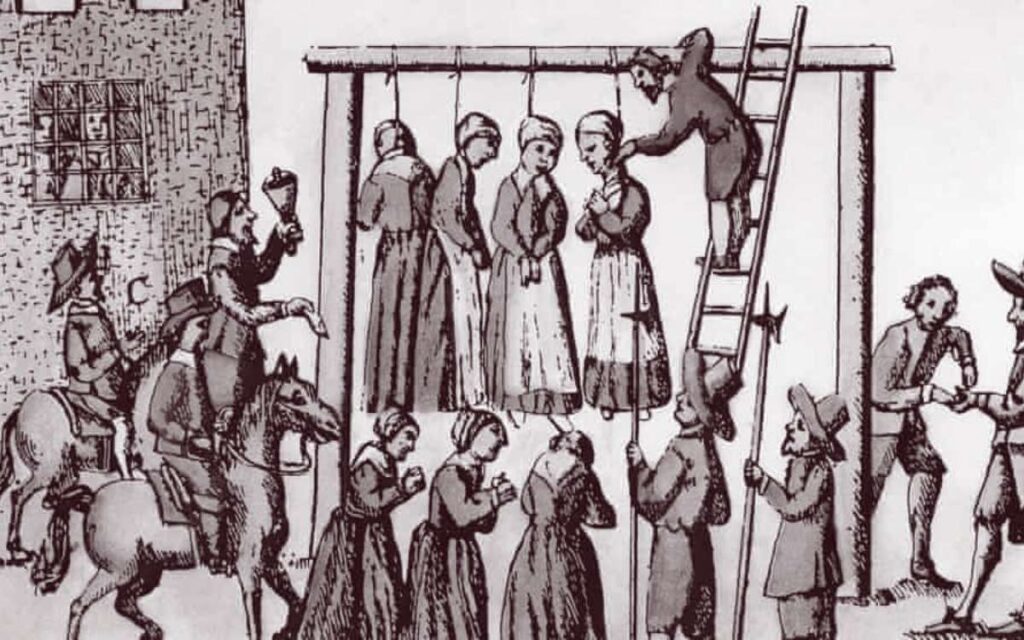The Scottish Government has taken the first steps to exonerate those accused of witchcraft over 300 years ago. CHRISTINE MILLER explains.

On International Women’s Day 2022, Scotland’s First Minister Nicola Sturgeon issued a formal posthumous apology to the thousands of people – primarily women – who were accused of being witches under the Witchcraft Act 1563, until 1736.
“Egregious Historic Injustice”
On Tuesday 8 March, First Minister Sturgeon addressed the Scottish Parliament in Holyrood, saying:
“Those who met this fate were not witches, they were people, and they were overwhelmingly women.
“At a time when women were not even allowed to speak as witnesses in a courtroom, they were accused and killed because they were poor, different, vulnerable or in many cases just because they were women.”
“Today, on International Women’s Day, I am choosing to acknowledge that egregious historic injustice and extend a formal posthumous apology to all those accused, convicted, vilified or executed under the Witchcraft Act 1563.”
The foundations of a repeal of the historic accusations have been widely welcomed by campaigners, such as the charity Remembering the Accused Witches of Scotland, who have been campaigning for an official apology from both church and government since 2018 – as well as a national monument to “remember and honour” the thousands of victims of the cruel witch hunt.
What was the Witchcraft Act of 1563?
Throughout Scotland, While there were more than 4,000 individuals accused of being a witch, it’s believed more than 2,500 people were executed on the charge of being witches.
Scotland was a paranoid place between the 16th and 18th centuries, with much of the frenzied fear sweeping the country attributed to then king, James VI of Scotland, later to be King James I of England and Ireland.
James believed that witchcraft was being used against his Danish bride, with those responsible nefariously tampering with the weather and cooking up maelstroms in an attempt to sink the fleet of ships that carried the pair.
The Witchcraft Act 1736 was introduced soon after and so began two centuries of suspicion, moral panic, and extreme brutality to anyone considered a witch.
Thou Shall Not Suffer a Witch to Live
The Scottish parliament of the day made performing witchcraft or consulting with anyone believed to be a witch an offence punishable by death.
An interactive map designed by Edinburgh University shows just how prominent witchcraft accusations were over 300 years ago in Scotland.
Of the 4,000 accused, roughly two-thirds were sent to their deaths. Almost 85% of those who perished were women.
Scotland certainly knew how to implicate, torture, and kill innocent victims on an unparalleled scale.
In fact, fives times as many people were executed in Scotland throughout the witch trials than in other places in Europe, where witch hunts were also prominent. Arguably, the most infamous witch trial occurred in Salem, Massachusetts, in the United States, only 300 people were accused, and just 19 people were executed.
Witchcraft Accusations and Executions
A range of inventive torture methods was employed to extract a confession from the accused.
Pilliwinks, a type of thumbscrew, were used on Geillis Duncan, a teenager accused of being one of those who had attempted to sink the king’s ship until her fingers splintered. The “Devil’s Mark” was found on her throat after being stripped naked and had her head shaved.
Agnes Sampson, an elderly woman, was subjected to unrelenting sleep deprivation – a standard method due to the “evidence”, aka hallucinations that it would yield. Sampson was then pinned to the wall with a “witches bridle”, a contraption composed of iron that would forcibly push four viciously-sharped prongs into the mouth.
These are just two stories of thousands, no doubt, just like them.
Those that somehow survived the torture were incarcerated in abhorrent living conditions with next to no sustenance to await their day in court, with many perishing before they could stand trial.
Once found guilty, they would be burned or slowly hanged for their “crimes”.
Justice for the Accused
Addressing parliament on Tuesday (8th March), Ms Sturgeon said: “Some will ask why this generation should say sorry for something that happened centuries ago.
“But it might actually be more pertinent to ask why it has taken so long.”
The apology from the First Minister is the first official recognition of the injustices suffered by the accused at the hands of the Scottish Government.
It is hoped by many campaigners that, alongside the welcomed apology, an official pardon will also be posthumously granted to the thousands of accused in the near future.
Here at The Spooky Isles, we are throwing our support behind Blackpool Dungeons’ petition to pardon The Pendle Witches officially. You can find out more and sign the petition by clicking here.








Good. Now Westminster should follow suit, along with a pardon to all
Well, I suppose an apology for an irrevocable injustice is better than nothing. In some cultures, like Japan’s, it is considered to be hugely important
Frankly, my feeling about an apology has always been that it changes nothing at all.
If you think that this apology will relieve, or mitigate the well deserved judgement awaiting these false witnesses, torturers, and murderers, well, I couldn’t
say; I am not their judge. Neither are you. If they get unearned luck in the next life that far exceeds the unearned horrors they inflicted on others, well, that comes only from a merciful God. If not, that comes from a typical observation of Jesus of Nazerath,
the promise that mercy will be given to those who show mercy…which they never did. Either way, may God’s will be done, not your will, nor mine, nor Westminster’s.
BG Curme